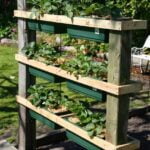Are you looking for unique and versatile materials to enhance your outdoor space? Look no further than railroad ties. In this article, we will explore the many ways in which these weathered wooden beams can be repurposed to create stunning DIY landscape features. From building retaining walls to designing garden beds, pathways, and more, railroad ties offer endless possibilities for elevating the aesthetic and functionality of your yard.
When it comes to landscaping projects, choosing the right materials is crucial for ensuring durability and longevity. In the following sections, we will provide a comprehensive guide to selecting the best railroad ties for your specific needs. Whether you’re aiming to build a sturdy retaining wall or create raised garden beds, understanding the different types and qualities of railroad ties will be essential for achieving your desired results.
Throughout this article, you’ll find step-by-step instructions, tips, and inspiration for incorporating railroad ties into various DIY landscape projects. From creating visually appealing pathways to constructing durable steps and stairs, there’s no limit to what you can achieve with these adaptable materials.
Additionally, we’ll cover important information on maintenance and safety to ensure that your railroad tie structures remain secure and well-maintained over time. So roll up your sleeves and get ready to unleash your creativity with these innovative ideas for using railroad ties in your outdoor space.
Choosing the Right Railroad Ties
When it comes to DIY landscape projects, choosing the right railroad ties is essential for the success and longevity of your design. Railroad ties, also known as cross ties or sleepers, are typically made from wood or concrete and have long been used in landscaping for their durability and rustic appearance. In this section, we will delve into the considerations for selecting the best materials for your specific landscaping needs.
One of the most important factors to consider when choosing railroad ties for your landscape project is the material. Wood railroad ties are a popular choice for their natural look and affordability, but they may be prone to rot and require more maintenance over time.
On the other hand, concrete ties offer greater durability and longevity, making them ideal for long-term landscaping solutions. It’s important to weigh the pros and cons of each material based on your budget, design preferences, and maintenance capabilities.
In addition to material, size and condition are also crucial factors in choosing the right railroad ties for your DIY landscape project. When selecting ties, be sure to inspect them for signs of decay or damage that could affect their structural integrity.
It’s also important to consider the size of the ties in relation to your specific project – while standard-sized ties are common for many applications, smaller or larger dimensions may better suit your individual needs. By carefully considering these factors, you can ensure that you select railroad ties that will be both functional and aesthetically pleasing in your landscape design.
| Factor | Considerations |
|---|---|
| Material | Wood vs. Concrete; pros and cons |
| Size | Standard vs. non-standard dimensions |
| Condition | Inspecting for decay or damage |
Building Retaining Walls
Railroad ties are a popular choice for building retaining walls in DIY landscape projects due to their sturdiness and durability. They can provide both functionality and aesthetic appeal to any outdoor space. When considering using railroad ties for building retaining walls, it’s important to follow step-by-step instructions to ensure the structure is sturdy and visually appealing. Here are some essential tips and guidelines for creating sturdy and attractive retaining walls using railroad ties.
Preparing the Site
Before you start building a retaining wall with railroad ties, it’s crucial to prepare the site properly. Clear the area of any debris, rocks, or plants, ensuring that the ground is level and compacted. This will create a solid foundation for your retaining wall and prevent any potential shifting or erosion over time.
Installing the Railroad Ties
Once the site is prepared, it’s time to install the railroad ties for your retaining wall. Start by placing the first layer of ties in the desired position, making sure they are level and aligned. Use a level to check for straightness as you lay each tie, adjusting as necessary. Then, continue stacking additional layers on top of each other until you reach your desired height for the retaining wall.
Anchoring and Backfilling
To ensure stability, it’s essential to anchor the railroad tie retaining wall securely. Drive rebar or metal stakes through the ties into the ground behind the wall at regular intervals. This will help prevent any shifting or movement of the structure over time. Once anchored, backfill behind the wall with gravel or drainage rock to provide support and improve drainage.
By following these step-by-step instructions, you can create sturdy and attractive retaining walls using railroad ties in your DIY landscape project. Whether you’re looking to level out a sloped yard or create defined garden beds, utilizing railroad ties can be an excellent choice for adding both function and beauty to your outdoor space.
Creating Garden Beds
Railroad ties are a versatile and affordable material that can be used for a variety of DIY landscape projects, including building raised garden beds and borders. Their durability makes them an excellent choice for creating long-lasting and visually appealing garden features.
When choosing railroad ties for your garden beds, it’s important to select the right materials. Look for ties that are in good condition, without excessive rot or damage. It’s also crucial to make sure that the ties you choose have not been treated with harmful chemicals, as these can leach into the soil and affect your plants. Consider purchasing new or recycled plastic railroad ties as an eco-friendly alternative.
To create raised garden beds with railroad ties, follow these simple steps:
- Measure out the area where you want to build the bed
- Lay out the railroad ties to form the perimeter of the bed
- Secure the ties together using rebar or screws
- Fill the bed with soil and compost before planting your desired vegetation
In addition to raised garden beds, you can use railroad ties to create borders around existing flower beds or vegetable gardens. Simply dig a trench along the edge of the area and place the ties vertically into the ground to form a sturdy border.
This not only adds structure and definition to your landscaping but also helps prevent soil erosion and weed encroachment. With some creativity and effort, you can transform your outdoor space by incorporating railroad ties into your landscape design.
Designing Pathways
Benefits of Using Railroad Ties for Pathways
Railroad ties can add a rustic and charming touch to your outdoor space when used to create pathways. The natural, weathered look of the ties can complement various landscaping styles, from traditional to modern. Additionally, railroad ties are durable and long-lasting, making them an excellent choice for pathways that will withstand heavy foot traffic.
Ideas for Incorporating Railroad Ties Into Walkways
There are numerous ways to incorporate railroad ties into the design of your pathways. One popular option is to use the ties as edging along the sides of a gravel or mulch pathway. This creates a defined border and prevents the loose material from spilling over into surrounding areas.
Another idea is to lay the ties horizontally in a staggered pattern to create a rustic-looking walkway surface. For a more polished look, consider using railroad ties as steps within the pathway, providing both function and visual interest.
Tips for Installation
When incorporating railroad ties into your pathways, it’s essential to ensure proper installation for longevity and safety. Start by outlining the desired pathway shape and size with stakes and string. Remove any grass or debris from the area before laying down a base material such as sand or gravel.
Then, place the railroad ties in position, ensuring they are level and securely anchored into the ground with rebar or landscaping spikes. Finally, fill in any gaps between the ties with gravel or mulch for a finished look.
Using railroad ties in designing pathways offers endless possibilities for creativity and functionality in your DIY landscape projects. Whether you opt for a simple border or a more intricate pathway design, these versatile materials can elevate the overall appeal of your outdoor space while providing lasting durability.
Building Steps and Stairs
When it comes to incorporating railroad ties into your landscape, one of the most impactful and visually striking projects you can take on is building steps and stairs. Not only do railroad tie steps add a rustic and natural element to your outdoor space, but they also provide durable and long-lasting solutions for navigating changing elevations in your yard.
Whether you’re looking to create a grand staircase or simply build a few small steps, railroad ties offer a versatile and budget-friendly option for achieving your landscaping goals.
To get started with using railroad ties for building steps and stairs in your landscape, it’s important to choose the right materials. Look for ties that are still in good condition, without extensive rot or damage.
It’s also essential to select pieces that are uniform in size and shape, as this will make the construction process easier and ensure a more polished end result. Additionally, consider whether you want to use new or used railroad ties – while used ties may offer a more weathered look, new ties may provide greater structural integrity.
Once you have your materials selected, it’s time to plan out the design for your steps or stairs. Take into account the natural flow of your landscape and consider how best to integrate the railroad ties into the existing environment. For a more natural look, consider incorporating curves or varying heights into your staircase design. And don’t forget about safety – be sure to securely anchor each tie into the ground to prevent shifting over time.
| Aspect | Details |
|---|---|
| Materials | Good condition, uniform size, consider new vs used |
| Design | Consider natural flow of landscape, incorporate curves/height variations |
| Safety | Securely anchor each tie into ground to prevent shifting over time |
Maintenance and Safety
Railroad ties are a popular choice for DIY landscape projects due to their durability and rustic charm. However, it’s essential to prioritize maintenance and safety when using railroad ties in your yard. Proper upkeep and secure installation are crucial for ensuring the longevity and stability of any structures built with railroad ties.
Here are some important tips for maintaining and securing railroad tie structures in your yard:
- Regular Inspection: Schedule routine inspections of your railroad tie structures to check for signs of wear, rot, or damage. Look for any loose connections or shifting of the ties, as these can compromise the stability of retaining walls, garden beds, or pathways.
- Treatment: Railroad ties are typically treated with creosote to prevent decay and pest infestations. However, it’s important to monitor the condition of the treatment over time. Consider applying a sealant or preservative to help maintain the integrity of the ties and protect them from environmental elements.
- Anchoring: To ensure the stability of retaining walls and other vertical structures built with railroad ties, use appropriate anchoring methods such as rebar or deadmen. These reinforcements can help prevent shifting or collapsing over time.
Ensuring the maintenance and safety of your railroad tie structures is crucial for the long-term success of your DIY landscape projects. By taking proactive measures to inspect, treat, and anchor these structures, you can enjoy their functionality and aesthetic appeal for years to come. Always prioritize safety when working with heavy materials like railroad ties and consult professional guidance if needed.
Final Thoughts
Railroad ties are a versatile and cost-effective material that can be used in a variety of DIY landscape projects. From building retaining walls to creating garden beds, designing pathways, and constructing steps and stairs, the possibilities for using railroad ties in your outdoor space are endless. The key is to choose the right materials and follow best practices for construction and maintenance.
When it comes to choosing the right railroad ties for your project, it’s important to consider factors such as size, condition, and treatment. Whether you opt for new or used ties, make sure they are free from decay and treated with preservatives to ensure longevity. Additionally, be sure to secure the ties properly to prevent shifting or instability over time.
In conclusion, incorporating railroad ties into your DIY landscape projects can add both functionality and visual appeal to your outdoor space. By following best practices for selection, construction, and maintenance, you can create sturdy and attractive features that will enhance the overall look of your landscaping. With the wealth of inspiration and education available on this topic, you’ll have no shortage of ideas for using railroad ties in creative ways to transform your outdoor environment.
Frequently Asked Questions
What Can I Make Out of Old Railroad Ties?
Old railroad ties can be repurposed in a variety of ways. They can be used to create borders for garden beds, pathways, or retaining walls. They can also be used to build steps or even furniture like benches or tables. With some creativity and DIY skills, old railroad ties can find new life in landscaping and home projects.
Can You Landscape With Railroad Ties?
Yes, it is possible to landscape with railroad ties. Railroad ties can be used to create sturdy and long-lasting retaining walls, raised flower beds, or define the edge of a garden or pathway.
However, it is important to note that treated railroad ties may contain chemicals that could leach into the soil, so it is essential to use caution and potentially seal the ties if they will come into contact with plants or edible crops.
What Can I Use Instead of Railroad Ties for Landscaping?
Instead of using railroad ties for landscaping, there are several alternative materials that can be used. Pressure-treated lumber, concrete blocks, natural stone, or recycled plastic timbers are all viable options for creating retaining walls, garden borders, or steps in a landscape design.
These alternatives provide similar functionality while offering different aesthetic looks and potentially being more environmentally friendly than traditional railroad ties made from pressure-treated wood.

Welcome to my gardening blog! I am passionate about plants and enjoy sharing my knowledge and experiences with others. In this blog, I will write about everything related to gardening, from tips on how to get started to updates on my own garden projects.





